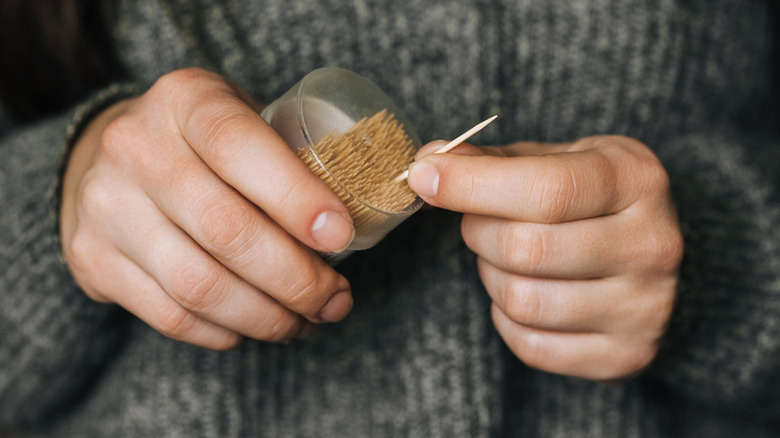The Toothpick Trick That Helps The Seedlings In Your Garden Thrive
We may receive a commission on purchases made from links.
Toothpicks aren't just useful to stick in appetizers on a party tray. They can also become your first line of defense against the dreaded cutworm. Cutworms are the baby versions of the common gray moth, living beneath the soil. They often wrap themselves around the base of a plant and feast away. They won't stop until the poor little stem is eaten through. The plant then topples to the ground and dies.
Hungry, hungry caterpillars might be great for a children's book, but aren't so fun when they're destroying your vegetable garden. Cutworms are just one of several bad worms in garden soil that can demolish your vegetable garden in the blink of an eye. Cutworms eat all kinds of plants, including tomatoes, beans, cabbage, and even many kinds of turf grass. You're also likely to find them among many insects on sweet basil plants. They typically do most of their snacking in the spring when sprouts are small and delicate, which makes them easier to eat.
A quick and cheap way to thwart cutworms in your garden involves grabbing some toothpicks from your kitchen. You'll need two toothpicks for every stalk you'd like to protect, so the number you need really depends on the young plants you feel might be under siege by cutworms. Any wooden toothpicks will do, such as Hopelf Bamboo Toothpicks. You can get 2,400 of them for $6.
Do this to stop cutworms in your garden
Toothpicks are an easy way to protect your vegetable sprouts, and just one method to learn when you're figuring out how to get rid of garden worms. Before getting started, make sure cutworms are the culprits wreaking havoc in your garden. You'll know cutworms have moved in by inspecting your plants closely.
Baby cutworm caterpillars usually feast on the leaves or roots of a plant until they get big enough to wrap themselves around the stalk and go in for the kill. They typically feed only at night and hide underground during the day, so they can be hard to spot. If you find holes in your leaves, try digging around the base of your plant to see if you spot one. Cutworms come in many colors, including brown, green, or even pink. They can also have spots or stripes. They can grow up to a couple of inches long.
To stop cutworms, simply take two toothpicks and place them closely on either side of a young stalk. Don't leave any room between the toothpick and the stalk, or the worm might be able to wiggle through. The toothpicks should prevent the cutworm from wrapping around the base of the plant and chewing through. If you have any toothpicks left over, you can use toothpicks to check to see if soil needs to be watered by poking them in the soil. If a toothpick comes out dry, then you might need to water.
